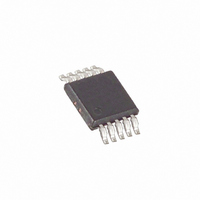MAX6695YAUB+T Maxim Integrated Products, MAX6695YAUB+T Datasheet - Page 13

MAX6695YAUB+T
Manufacturer Part Number
MAX6695YAUB+T
Description
IC SENSOR TEMP SMBUS 10-UMAX
Manufacturer
Maxim Integrated Products
Datasheet
1.MAX6696AEET.pdf
(20 pages)
Specifications of MAX6695YAUB+T
Function
Temp Monitoring System (Sensor)
Topology
ADC, Multiplexer, Register Bank
Sensor Type
External & Internal
Sensing Temperature
-40°C ~ 125°C, External Sensor
Output Type
I²C™/SMBus™
Output Alarm
Yes
Output Fan
Yes
Voltage - Supply
3 V ~ 3.6 V
Operating Temperature
-40°C ~ 125°C
Mounting Type
Surface Mount
Package / Case
10-MSOP, Micro10™, 10-uMAX, 10-uSOP
Full Temp Accuracy
+/- 3 C
Digital Output - Bus Interface
Serial (2-Wire)
Digital Output - Number Of Bits
10 bit + Sign
Maximum Operating Temperature
+ 125 C
Minimum Operating Temperature
- 40 C
Lead Free Status / RoHS Status
Lead free / RoHS Compliant
Table 6. Configuration Byte Functions
begun, after which the device returns to standby mode.
If a conversion is in progress when a one-shot com-
mand is received, the command is ignored. If a one-
shot command is received in autoconvert mode
(RUN/STOP bit = 0) between conversions, a new con-
version begins, the conversion rate timer is reset, and
the next automatic conversion takes place after a full
delay elapses.
To avoid false triggering of the MAX6695/MAX6696 in
noisy environments, a fault queue is provided, which
can be enabled by setting bit 5 (configuration register)
to 1. Four channel 1 fault or two channel 2 fault events
must occur consecutively before the fault output (OT2)
becomes active. Any reading that breaks the sequence
resets the fault queue counter. If there are three over-
limit readings followed by a within-limit reading, the
remote channel 1 fault queue counter is reset.
The configuration byte register (Table 6) is a read-write
register with several functions. Bit 7 is used to mask
(disable) ALERT interrupts. Bit 6 puts the device into
software standby mode (STOP) or autonomous (RUN)
mode. Bit 5, when 1, enables the Fault Queue. Bit 4 is
reserved. Bit 3 is used to select either remote channel 1
or remote channel 2 for reading temperature data or for
setting or reading temperature limits. Bit 2 disables the
SMBus timeout, as well as the Alert Response. Bit 1
masks ALERT interrupt due to channel 2 when high. Bit
0 masks ALERT interrupt due to channel 1 when high.
7(MSB)
BIT
Dual Remote/Local Temperature Sensors with
6
5
4
3
2
1
0
MASK Alert Channel 2
MASK Alert Channel 1
SMB Timeout Disable
Remote 2 Select
Configuration Byte Functions
Fault Queue
______________________________________________________________________________________
RUN/STOP
MASK1
NAME
RFU
Fault Queue Function
STATE
POR
0
0
0
0
0
0
0
0
Mask ALERT interrupts when 1.
Standby mode control bit. If 1, immediately stops converting and enters
standby mode. If zero, it converts in either one-shot or timer mode.
Fault queue enables when 1. When set to 1, four consecutive faults must occur
before OT2 output is asserted.
Reserved.
0: Read/write remote 1 temperature and set-point values.
1: Read/write remote 2 temperature and set-point values.
When set to 1, it disables the SMBus timeout, as well as the alert response.
When set to 1, it masks ALERT interrupt due to channel 2.
When set to 1, it masks ALERT interrupt due to channel 1.
SMBus Serial Interface
The status registers (Tables 7 and 8) indicate which (if
any) temperature thresholds have been exceeded and
if there is an open-circuit fault detected with the exter-
nal sense junctions. Status register 1 also indicates
whether the ADC is converting. After POR, the normal
state of the registers’ bits is zero (except bit 7 of status
register 1), assuming no alert or overtemperature con-
ditions are present. Bits 0 through 6 of status register 1
and bits 1 through 7 of status register 2 are cleared by
any successful read of the status registers, unless the
fault persists. The ALERT output follows the status flag
bit. Both are cleared when successfully read, but if the
condition still exists, they reassert at the end of the next
conversion.
The bits indicating OT1 and OT2 are cleared only on
reading status even if the fault conditions still exist.
Reading the status byte does not clear the OT1 and
OT2 outputs. One way to eliminate the fault condition is
for the measured temperature to drop below the tem-
perature threshold minus the hysteresis value. Another
way to eliminate the fault condition is by writing new
values for the RWO2E, RWO2I, RWO1E, RWO1I, or
HYST registers so that a fault condition is no longer
present.
When autoconverting, if the T
close together, it is possible for both high-temp and
low-temp status bits to be set, depending on the
amount of time between Status Read operations. In
these circumstances, it is best not to rely on the status
bits to indicate reversals in long-term temperature
changes. Instead, use a current temperature reading to
establish the trend direction.
FUNCTION
Status Byte Functions
HIGH
and T
LOW
limits are
13












